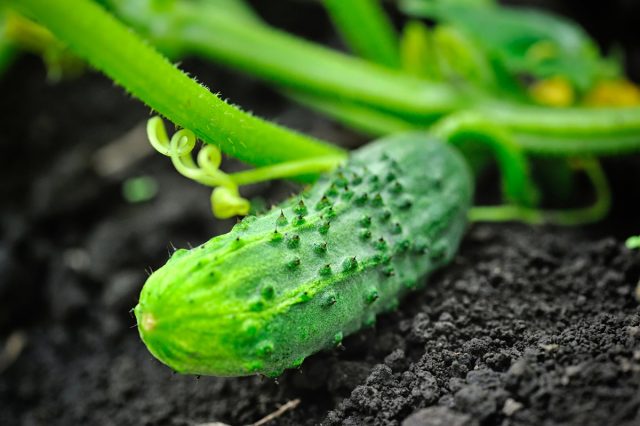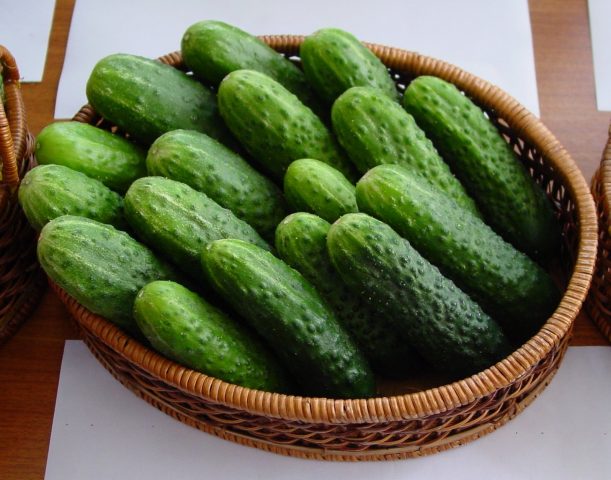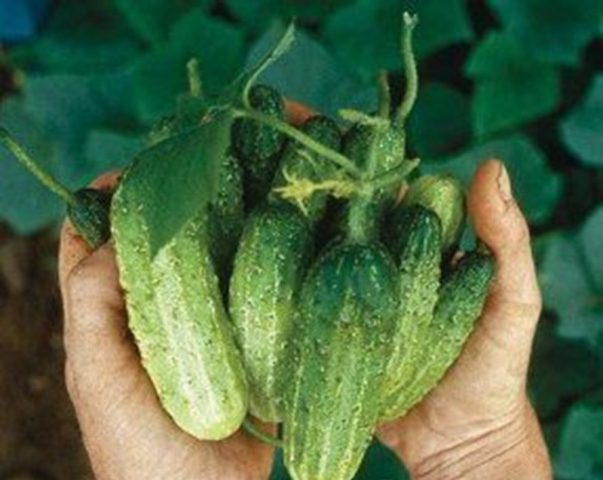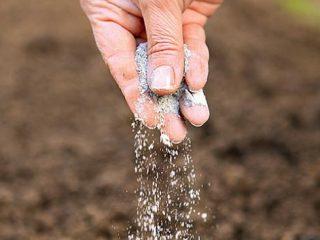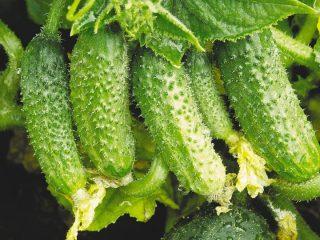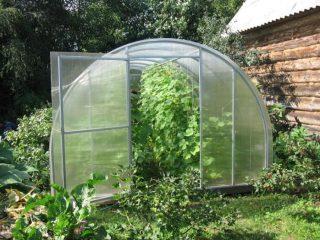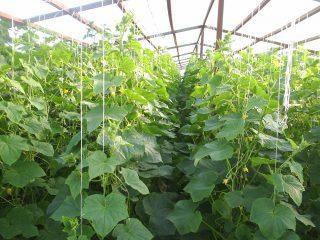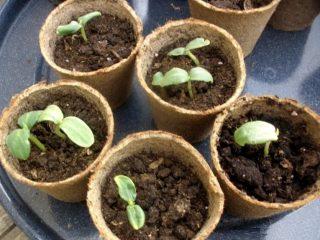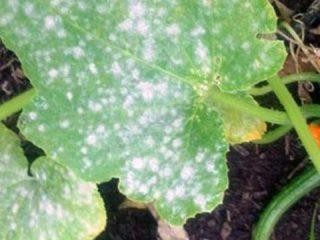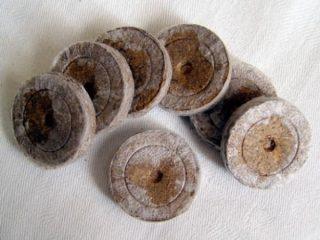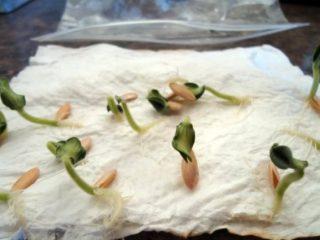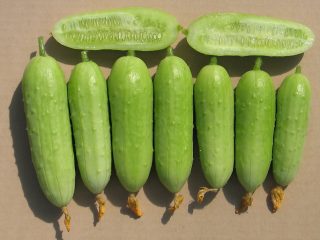Content
The Barabulka cucumber is a new generation hybrid, adapted to the weather conditions of Russia. After experimental cultivation, in 2008 the variety was added to the State Register list. The copyright holder and supplier of seeds is the agricultural company Gavrish.
Detailed description of the variety
The Red Mullet cucumber belongs to the indeterminate type, reaching 2.5 m without height restrictions. The crop is early ripening, the fruits ripen in 45 days. Cucumbers of this variety do not form a large number of stepsons; the plant is open, which allows for unhindered harvesting. The variety is cultivated depending on the climatic characteristics of the region: in open ground (OG) and in a protected area.
Cucumber is characterized by parthenocarpy and produces only female flowers. This varietal feature is a guarantee of a stable harvest. The Red Mullet hybrid does not need pollinators, ovaries are formed on each flower, and all green plants grow to biological ripeness.
External description of the Barabulka cucumbers shown in the photo:
- The main stem is of medium volume, densely pubescent, with a ribbed surface, the structure is rigid, flexible, the color is gray-green.The side shoots are thin, with high arborization.
- The foliage of the bush is dense, the leaves are large in size, attached to long petioles. The surface is uneven, finely studded, with dark green veins. The edges are wavy, the leaf blade is heart-shaped.
- The root of the Red Mullet cucumber is powerful, highly branched, located close to the surface, the root circle occupies about 60 cm.
- The variety blooms with yellow flowers located in the leaf node.
Description of fruits
The fruits of the Barabulka variety have the same shape and weight. If it was not possible to harvest on time, the Mullet Cucumber f1 does not age: overripe fruits do not thicken or turn yellow. The taste remains unchanged, there is no acid.
External characteristics:
- greens have the shape of an oblong cylinder, average length 12 cm, weight 100 g;
- the surface is light green in color with dense small tubercles equipped with short spines;
- The peel of the cucumber is thin, durable, and tolerates mechanical stress and heat treatment well. The surface is glossy, the coating is insignificant;
- the pulp is juicy, dense in consistency, beige in color, there are no voids, the seed chambers are filled with small rudiments;
- the taste is sweet, there is no acid or bitterness, the aroma is weakly expressed.
According to reviews from vegetable growers, Red Mullet f1 cucumbers are stored for 5 days, do not lose weight or presentation, and tolerate transportation well. The variety was created for mass cultivation and use in the food industry.
This variety is ideal for preservation. The culture is popular among amateur vegetable growers.Cucumbers grown on the site are consumed fresh and processed for winter preparations. Pickled fruits are elastic, crispy, without emptiness in the pulp.
Characteristics of red mullet cucumbers
The Barabulka cucumber variety was created for cultivation throughout the Russian Federation, so the originators placed emphasis during hybridization on the frost resistance of the plant. In the risky farming zone, the variety is grown in heated greenhouses. In temperate climates, the covering method is used; in the South, the open method is used. At the initial stage of the growing season, cucumber tolerates temperatures dropping to +6 0C, in warm regions in spring the crop is not covered with film.
The drought resistance of the Barabulka variety is average; without timely irrigation, cucumbers slow down the growing season. The ovaries turn yellow and fall off. Excess moisture is undesirable for the root system; root rot and the spread of fungal diseases are possible. The variety tolerates high temperatures well and can grow in an area exposed to the sun or in partial shade. In greenhouses, additional lighting is not required for photosynthesis.
Productivity
Cucumbers of the Barabulka variety are an early-ripening crop. From the moment the young shoots appear until the greens are ripe, 40–45 days pass. The hybrid bears fruit for a long time; the harvest is harvested in several stages. The ripening of greens occurs in the first ten days of June. The last collection is carried out in early September. The timing is individual in each climate zone.
The variety is self-pollinating and produces high yields. If the variety is planted in a greenhouse, about 7 kg of fruits are removed from each plant; in OG the figure is lower and is approximately 6 kg. Cucumber bushes are arranged 3 by 1 m2, average yield per 1 m2 – 20 kg. The level of fruiting is affected by drafts, moisture deficiency and non-compliance with agricultural technology.The Red Mullet variety is grown only by trellis; the ovaries should not be allowed to come into contact with the ground.
Resistance to pests and diseases
The Barabulka cucumber variety has a fairly stable immunity. Downy mildew, leaf mosaic, and powdery mildew are not observed on cucumbers. If the greenhouse is not ventilated and the humidity is high and the temperature is low, anthracnose may develop.
To combat fungal infection, bushes are treated with colloidal sulfur, and in the spring for prevention - with copper sulfate. In greenhouses, insects do not parasitize cucumbers. The Whitefly caterpillar is found in the OG. Pests are collected manually, and in case of large clusters they are treated with “Commander”.
Pros and cons of the variety
When choosing a variety for planting on a personal plot, preference is given to the Barabulka cucumber, which has a number of advantages:
- high yield, independent of weather conditions;
- versatility of the fruit. Due to their elasticity and small size, greens are ideal for canning;
- frost resistance, shade tolerance;
- long shelf life;
- resistance to mechanical damage during transportation;
- balanced taste;
- early ripening and long fruiting;
- resistance to infections.
The disadvantage of the Barabulka variety is that the hybrid does not produce planting material.
Growing rules
According to reviews from vegetable growers, the Barabulka variety of cucumbers is grown using seedlings and planting seeds directly on the garden bed. If the goal of cultivating a crop is to obtain an early harvest, seedlings are first grown. Then they place it on the site. This method is well suited for greenhouses. In OG, cucumbers are grown from seeds.
Sowing time
Seedlings of the Barabulka variety of cucumbers grow quickly. Young shoots are planted in a greenhouse after 3 leaves have formed on the stem. From the moment the seeds are planted until the plant is planted, 25 days pass. Cucumbers are planted on the plot if the ground has warmed up to +14 0 C. Approximately, seed sowing occurs at the beginning of April. The seedlings are transferred to an open area in mid-May. Seeds are planted in a greenhouse in early May, in an unprotected area 14 days later.
Selecting a location and preparing beds
The site is chosen to be open to the sun; temporary shading is allowed. A prerequisite is that the soil must be well drained; nearby groundwater is not suitable for the variety. Cucumbers do not react well to the north wind, so they take protective measures against drafts.
In the fall the site is dug up. If the soil is acidic, add lime or dolomite flour. Remains of weeds are removed, manure and ammonium nitrate are added. In the spring, the bed is loosened and re-fertilized with organic matter.
How to plant correctly
Cucumbers do not tolerate transplantation well, so the seeds for seedlings are planted in peat cups. In order not to injure the root, the seedlings are placed on the site together with the container. A hole is made 5 centimeters larger than the peat cup, and the seedling is filled to the bottom leaves. At 1 m2 place 3 seedlings. For seeds, make a hole 3.5 cm deep. The planting pattern is the same for the exhaust zone and the closed area. Row spacing – 45 cm, distance between bushes – 35 cm.
Aftercare for cucumbers
Red mullet cucumbers are grown in the traditional way:
- In the greenhouse, watering is moderate, every 2 days in the evening, it is best to use the drip method. The OG is guided by weather conditions.
- Fertilizing with ammonium nitrate is carried out at the beginning of the growing season, phosphorus and potassium fertilizers are applied after green plants begin to form.
- Loosening the top layer of soil and weeding weed – procedures are mandatory and are carried out as necessary.
The Barabulka variety is grown only by trellis method. During the growing season, the cucumber is fixed to a support; the top of the head is twisted at the height of the trellis. The bush is formed with one shoot, the stepsons are removed as they appear, and yellowed and excess leaves are cut off.
Conclusion
The Red Mullet cucumber is an indeterminate hybrid of a new generation. A self-pollinating plant produces a stable, high yield. The variety was bred for the food industry. Cultivate a culture through protected and open methods. The fruits are characterized by a balanced taste and light aroma, and are universal in use.
Reviews of red mullet cucumbers
